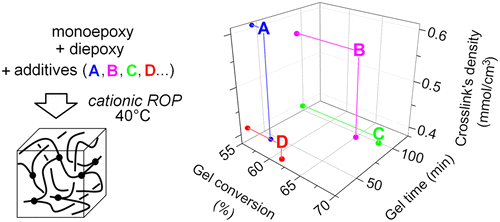当前位置:
X-MOL 学术
›
Macromolecules
›
论文详情
Our official English website, www.x-mol.net, welcomes your feedback! (Note: you will need to create a separate account there.)
Control of Gelation and Network Properties of Cationically Copolymerized Mono- and Diglycidyl Ethers
Macromolecules ( IF 5.5 ) Pub Date : 2018-07-05 00:00:00 , DOI: 10.1021/acs.macromol.8b00406 Thomas Vidil 1 , Michel Cloître 1 , Francois Tournilhac 1
Macromolecules ( IF 5.5 ) Pub Date : 2018-07-05 00:00:00 , DOI: 10.1021/acs.macromol.8b00406 Thomas Vidil 1 , Michel Cloître 1 , Francois Tournilhac 1
Affiliation

|
The development of low temperature curing systems has become a major objective in thermoset technologies for both environmental and economic reasons. The use of protic and chelating additives have recently been underlined for the control of the cationic ring-opening polymerization of epoxies, a curing mode that is very efficient at temperatures close from the ambient but that can easily runaway. In this paper, we propose to use this strategy to control the kinetics of the cationic copolymerization of a diepoxy monomer (diglycidyl ether of bisphenol A, DGEBA) with a monoepoxy monomer (phenyl glycidyl ether, PGE). The purpose of the study is to tune the cross-link density (νe) in order to control the mechanical properties of the materials. The sol–gel transition was first investigated in details at several frequencies by using the Fourier transform mechanical spectroscopy method (FTMS). We found that the gel time (tgel) and the critical conversion (αgel) can be controlled to a great extent by promoting transfers and complexing cationic species involved in the polymerization mechanism. The FTMS method also gives some insight into the structure of the polymer clusters at the sol–gel transition. The results indicate that the various additives used to control the transition have mostly no influence on the clusters’ structure. The properties of the fully cured networks were then investigated via swelling and dynamic mechanical measurements. Both methods indicate that νe is strongly influenced by the cross-linker content (DGEBA) but also by the additive used to control the curing kinetics. Interestingly, the measurement of the tensile properties at large deformations demonstrates that the resulting system offers a series of materials with a wide range of mechanical properties.
中文翻译:

阳离子共聚单缩水甘油醚和二缩水甘油醚的凝胶化和网络性质的控制
出于环境和经济原因,低温固化系统的开发已成为热固性技术的主要目标。最近已经强调了使用质子和螯合添加剂来控制环氧树脂的阳离子开环聚合,这种固化模式在接近环境温度下非常有效,但很容易失控。在本文中,我们建议使用这种策略来控制双环氧单体(双酚A的二环氧甘油醚,DGEBA)与单环氧单体(苯基环氧甘油醚,PGE)的阳离子共聚动力学。该研究的目的是为了调整交联密度(ν Ë),以控制材料的机械性能。首先通过使用傅立叶变换机械光谱法(FTMS)在几个频率上详细研究了溶胶-凝胶转变。我们发现,凝胶时间(吨凝胶)和临界转换(α凝胶可以通过促进转移和使参与聚合机理的阳离子种类络合而在很大程度上控制)。FTMS方法还可以洞察溶胶-凝胶转变过程中聚合物簇的结构。结果表明,用于控制过渡的各种添加剂对簇的结构几乎没有影响。然后,通过溶胀和动态力学测量研究完全固化网络的性能。这两种方法都表明,ν Ë交联剂含量(DGEBA)强烈影响着它,但控制固化动力学的添加剂也对它有很大的影响。有趣的是,在大变形下对拉伸性能的测量表明,所得系统提供了一系列具有广泛机械性能的材料。
更新日期:2018-07-05
中文翻译:

阳离子共聚单缩水甘油醚和二缩水甘油醚的凝胶化和网络性质的控制
出于环境和经济原因,低温固化系统的开发已成为热固性技术的主要目标。最近已经强调了使用质子和螯合添加剂来控制环氧树脂的阳离子开环聚合,这种固化模式在接近环境温度下非常有效,但很容易失控。在本文中,我们建议使用这种策略来控制双环氧单体(双酚A的二环氧甘油醚,DGEBA)与单环氧单体(苯基环氧甘油醚,PGE)的阳离子共聚动力学。该研究的目的是为了调整交联密度(ν Ë),以控制材料的机械性能。首先通过使用傅立叶变换机械光谱法(FTMS)在几个频率上详细研究了溶胶-凝胶转变。我们发现,凝胶时间(吨凝胶)和临界转换(α凝胶可以通过促进转移和使参与聚合机理的阳离子种类络合而在很大程度上控制)。FTMS方法还可以洞察溶胶-凝胶转变过程中聚合物簇的结构。结果表明,用于控制过渡的各种添加剂对簇的结构几乎没有影响。然后,通过溶胀和动态力学测量研究完全固化网络的性能。这两种方法都表明,ν Ë交联剂含量(DGEBA)强烈影响着它,但控制固化动力学的添加剂也对它有很大的影响。有趣的是,在大变形下对拉伸性能的测量表明,所得系统提供了一系列具有广泛机械性能的材料。



























 京公网安备 11010802027423号
京公网安备 11010802027423号